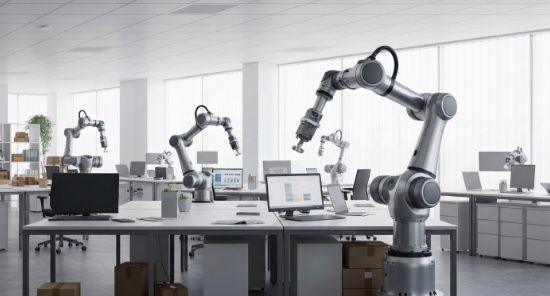How RPA Transforms Industries: Insights and Examples
How RPA Transforms Industries: Insights and Examples

Key Highlights
- Robotic Process Automation (RPA) uses software robots to mimic human actions, automating repetitive digital tasks.
- Key business benefits include significant cost savings, improved accuracy, and increased process efficiency.
- This automation technology is transforming industries like finance, healthcare, and manufacturing.
- RPA bots handle tasks like data entry, report generation, and customer service inquiries.
- Modern RPA platforms integrate with artificial intelligence to handle more complex business process automation.
- Successful RPA implementation frees human workers to focus on more strategic, high-value work.
Introduction
Imagine a workforce that operates 24/7 without making mistakes. This is the reality that Robotic Process Automation (RPA) brings to businesses across the globe. By automating rule-based, repetitive tasks, RPA is revolutionizing how organizations approach their daily business process. This powerful technology acts as a key driver for digital transformation, allowing companies to streamline operations, reduce costs, and empower employees. Are you ready to see how this technology can change the way you work?
RPA: Transforming Business Processes with Automation
Understanding Robotic Process Automation (RPA)
Robotic Process Automation (RPA) revolutionizes how businesses approach routine work by using software robots to streamline operations. By automating repetitive tasks like data entry, companies can significantly reduce human error and enhance operational efficiency. RPA technology integrates effortlessly with existing systems, enabling businesses to leverage automation tools without disrupting their current processes. This powerful solution not only leads to cost savings but also improves customer satisfaction by allowing human workers to focus on more complex tasks that require creativity and human intelligence.
What Makes RPA Distinct from Traditional Automation?
While traditional automation often requires deep integration with a system's backend, involving complex coding and API development, RPA technology operates differently. It works at the user interface level, just like a person would. This is a key distinction that makes RPA more flexible and easier to implement.
Essentially, software robots replicate human actions on a screen. They click buttons, navigate menus, and enter data into fields by following a predefined script. This ability to interact with applications through their graphical user interface (GUI) means RPA can automate processes even on legacy systems that lack modern APIs.
This approach to business process automation allows organizations to connect disparate systems quickly without undertaking major IT overhaul projects. Instead of building custom integrations, you can deploy a bot to transfer information from one application to another, making it a versatile and powerful automation technology.
How RPA Works: Core Concepts and Technologies
Robotic Process Automation (RPA) operates by deploying software bots that mimic human actions across digital systems. These bots interact with applications, manage data entry, and perform repetitive tasks, enhancing operational efficiency. Core technologies such as machine learning and natural language processing complement RPA, enabling better handling of unstructured data and improving customer experiences. By integrating these advanced technologies, RPA solutions help businesses streamline processes, reduce human error, and facilitate digital transformation, ultimately leading to significant cost savings and improved output across various industries.
Key Features of RPA Software
When you're exploring RPA software, it's important to know what features will deliver the most value. A modern automation platform should be more than just a tool for simple task automation; it should support your entire automation journey, from discovery to deployment and management.
Look for software technology that is user-friendly, scalable, and secure. The right platform will empower both your technical and business teams to contribute to process automation efforts. Let's look at some of the specific capabilities you should consider.
User-Friendly Design and Integration Capabilities
A key feature of effective RPA tools is a user-friendly design. Many modern platforms offer a low-code or no-code development environment. This means business users without deep technical skills can build their own automations using drag-and-drop interfaces and pre-built components. This accessibility accelerates business automation and empowers more people within the organization.
Another critical aspect is the software's ability to integrate with your existing systems. The platform should connect seamlessly with a wide range of enterprise applications, from legacy software to modern cloud services. This interoperability is vital for creating end-to-end automated workflows that span multiple departments and systems.
To ensure you can maximize your investment, look for a platform that includes:
- An intuitive user interface for easy bot creation.
- Pre-built connectors for popular enterprise applications.
- Support for both UI and API-based integration.
- A marketplace of reusable automation components.
Scalability, Security, and Compliance Aspects
As your automation initiatives grow, scalability becomes crucial. A robust RPA software platform allows you to add more bots quickly to meet increasing demand without significant infrastructure overhead. Whether you need to handle seasonal peaks or support business growth, the ability to scale your digital workforce efficiently is a major advantage.
Security is another non-negotiable feature. Since RPA bots often access and handle sensitive data, the platform must have strong security controls. Look for features like role-based access control, encrypted data storage, and detailed audit trails. These capabilities ensure that only authorized users can create or run automations and provide a clear record of every action a bot takes.
Furthermore, these audit trails are essential for compliance. By enforcing standardized processes and documenting every step, RPA helps organizations meet regulatory requirements. This ensures that all automated tasks are performed consistently and transparently, simplifying audits and reducing compliance risks.
Business Benefits of Implementing RPA
The business benefits of implementing RPA are substantial and can be felt across an entire organization. Beyond simple automation, an RPA implementation drives significant improvements in process efficiency and delivers impressive cost savings. It’s a powerful tool that accelerates digital transformation efforts.
By taking over repetitive, manual tasks, RPA allows your employees to focus on more strategic initiatives that require human creativity and judgment. Let’s explore some of the most impactful advantages that RPA offers.
Enhancing Productivity and Process Efficiency
One of the most immediate benefits of process automation is a dramatic boost in productivity. RPA bots can perform routine tasks much faster than human workers. A process that might take an employee hours to complete can often be finished by a bot in just minutes.
This increased speed directly translates to greater operational efficiency. What's more, RPA bots can work around the clock, 24/7, without breaks or fatigue. This ensures that critical business processes continue running outside of normal working hours, keeping your operations moving forward without interruption.
By automating repetitive tasks, you can achieve:
- Faster completion of high-volume tasks.
- Continuous operation, 24/7.
- Elimination of bottlenecks in workflows.
- Standardized and consistent execution of processes.
Cost Savings and Improved Accuracy
Implementing process automation leads to significant cost savings. By automating tasks, you reduce the labor hours required to perform them, which directly lowers operational costs. According to some reports, organizations can see savings of nearly 30% from their operational costs after adopting RPA.
Another major benefit is the reduction of human error. When people perform monotonous, repetitive tasks, mistakes are inevitable. However, RPA bots follow their programming precisely every time, eliminating costly errors in areas like data entry and transaction processing. This improved accuracy reduces the need for rework and enhances the quality of your data.
This focus on accuracy and efficiency is a cornerstone of business process improvement. By ensuring tasks are done correctly the first time, RPA not only saves money but also enhances the reliability of your operations, contributing to better overall performance.
Common Tasks Automated Using RPA
RPA is incredibly versatile, but it truly shines when applied to high-volume, rule-based, and repetitive tasks. From simple data entry to complex report generation, RPA solutions offer a way to streamline work across various business functions. Tools for process discovery can even help you identify the best automation opportunities.
This automation technology is particularly effective at tasks that involve moving information between multiple systems. Let's examine some of the most common processes that organizations are automating with RPA.
Data Entry and Management
Data entry is one of the most common and beneficial tasks to automate with RPA. Manually inputting information from one system to another is time-consuming and prone to errors. RPA bots can handle this work effortlessly, extracting data from various sources and entering it into the target systems with perfect accuracy.
An automation platform can be configured to pull information from emails, spreadsheets, databases, and even scanned documents. The RPA bots then validate this data based on predefined rules before inputting it into ERP, CRM, or other business applications. This ensures data consistency and integrity across your organization.
Common data management tasks automated by RPA include:
- Copying data from spreadsheets to a CRM system.
- Extracting information from invoices and entering it into an accounting application.
- Updating customer records across multiple platforms.
- Migrating data between legacy and modern systems.
Automated Reporting and Analytics
Generating regular reports is another task perfectly suited for automation. Many employees spend hours each week or month gathering data from different sources, compiling it into a spreadsheet, and formatting it for presentation. RPA can automate this entire process of creating reports.
Bots can be scheduled to collect data from various systems, consolidate it, and generate standardized reports at specified intervals. This ensures that stakeholders receive timely and accurate information without any manual effort. For more advanced needs, RPA can be combined with machine learning to produce more sophisticated analytics and real-time insights.
Furthermore, process mining tools can analyze the data collected by bots to identify inefficiencies and opportunities for further improvement. This continuous feedback loop helps refine both your automated and manual workflows, leading to even greater operational excellence.
Industry Use Cases: RPA in Action
The application of RPA technology extends across virtually every industry. Different business units are discovering unique use cases where automating digital tasks can deliver immense value. By handling repetitive parts of a business process, RPA helps organizations streamline operations and enhance service delivery.
From finance and healthcare to manufacturing and retail, millions of bots are at work globally. Let’s look at some specific examples of how RPA is making a significant impact in various sectors.
RPA in Financial Services and Banking
The financial services industry was an early adopter of RPA, and for good reason. The sector is filled with rule-based, high-volume processes that are ideal for business process automation. RPA software helps banks and financial institutions improve efficiency, reduce costs, and enhance compliance.
For example, bots can automate loan processing by gathering applicant data, performing credit checks, and generating approval documents. This speeds up the entire process, leading to a better customer experience and allowing employees to handle more complex cases. The cost savings from automating such tasks are often substantial.
RPA is used across various functions in banking and finance to drive efficiency and accuracy.
| Task Category | Specific RPA Application |
|---|---|
| Account Management | Automating account reconciliation and month-end closing reports. |
| Compliance | Generating compliance reports and monitoring transactions for fraud. |
| Customer Onboarding | Verifying customer information and setting up new accounts. |
| Mortgage Processing | Extracting data from applications and verifying documents. |
RPA in Healthcare and Life Sciences
In the healthcare and life sciences sectors, RPA is transforming administrative and clinical processes. The industry deals with vast amounts of sensitive data and complex workflows, making it a prime candidate for automation. RPA bots can help streamline operations while ensuring data accuracy and compliance.
One common use case is patient scheduling. Bots can manage appointment bookings, send reminders, and handle cancellations, which frees up staff to focus on patient care. This not only improves efficiency but also enhances patient and customer satisfaction by reducing wait times and providing timely communications.
Another critical application is in claims processing. RPA can automate the tedious process of extracting patient information, verifying insurance details, and submitting claims. This reduces processing times, minimizes errors, and helps healthcare providers receive payments faster, improving the revenue cycle.
Manufacturing, Retail, and Supply Chain Examples
The impact of process automation is also deeply felt in manufacturing, retail, and supply chain management. These industries rely on precise coordination and efficient operations to succeed. RPA helps them automate key processes, from inventory management to order fulfillment.
By connecting disparate systems and automating manual tasks, companies in these sectors can reduce costs, improve accuracy, and respond more quickly to market demands. Let's delve into some specific examples of how RPA is being used.
Process Optimization in Manufacturing
In the manufacturing sector, process optimization is key to maintaining a competitive edge. RPA technology offers a powerful way to streamline operations without overhauling existing infrastructure. For example, many manufacturers rely on legacy systems that don't easily communicate with each other.
RPA can act as a bridge between these systems. Bots can extract data from an inventory management system and enter it into a procurement application, automating the reordering of materials when stock levels are low. This ensures the production line never runs out of essential components.
This automation technology is also used for quality reporting and supply chain coordination. Bots can collect production data, generate quality control reports, and automate communications with suppliers, providing real-time visibility and improving overall efficiency on the factory floor.
Streamlining Operations in Retail and Logistics
The retail and logistics industries are all about speed and accuracy, and process automation is helping them achieve both. From managing inventory to processing orders, RPA streamlines critical business functions that directly impact the customer experience.
For instance, in the supply chain, bots can track shipments, update inventory records, and automate invoicing. This reduces manual effort and provides real-time visibility into the movement of goods. In retail, RPA can enhance customer service by empowering agents with instant access to order information and history.
Key areas where RPA is making a difference include:
- Order Processing: Automating order entry, status updates, and confirmations.
- Inventory Management: Tracking stock levels and automatically generating purchase orders.
- Customer Support: Providing chatbots with data to answer common queries 24/7.
- Demand Planning: Aggregating sales data to help forecast future demand.
Challenges and Considerations for RPA Adoption
While the benefits of RPA are clear, a successful RPA implementation requires careful planning. Embarking on this journey without a solid automation strategy can lead to unexpected challenges and risks. It's more than just a technology project; it's a business transformation.
One of the biggest hurdles is managing the human element through effective change management. It's crucial to prepare your organization for the shift in how work gets done. Let's look at some of the common complexities and how to address them.
Implementation Complexity and Change Management
The complexity of an RPA implementation can vary. While some simple task automations are straightforward, enterprise-wide adoption requires a strategic approach. Identifying the right processes to automate is a critical first step. The best candidates are standardized, rule-based, and high-volume tasks.
A significant challenge is change management. Employees may fear that RPA technology will replace their jobs, leading to resistance. Clear communication is essential to show how automation will free them from tedious work and allow them to focus on more engaging, higher-value activities. Involving business users in the design process can also help build buy-in.
Ultimately, the goal is to create a culture where automation is seen as a tool for enhancing operational efficiency, not as a threat. Proper training and a focus on the benefits for employees will smooth the transition and ensure a successful implementation.
Addressing Risks and Ensuring Long-Term Success
To ensure the long-term success of your automation strategy, it's vital to address potential risks from the outset. One major concern is data security. Since bots access sensitive systems, strong governance practices are necessary to prevent security breaches and protect data.
Another risk is a lack of maintenance. Business applications and processes change over time, and your bots will need to be updated accordingly. Without a plan for continuous improvement and maintenance, automations can break, disrupting operations. Establishing a Center of Excellence (CoE) is one of the best practices for managing this.
To mitigate risks and set your program up for success, focus on:
- Implementing strong governance and security protocols.
- Creating a clear maintenance and update plan for your bots.
- Starting with small, high-impact projects to demonstrate ROI.
- Developing a long-term automation strategy that aligns with business goals.
Essential Skills and Roles for Working With RPA
As RPA becomes more integrated into business operations, new skills and roles are emerging. Building a successful automation program requires a mix of technical competencies and business acumen. From the RPA developer who builds the bots to the project manager who oversees the implementation, having the right talent is key.
This doesn't just impact IT; human resources also plays a role in identifying and developing the necessary skills across the organization. Let's explore the key competencies needed to thrive in an automated workplace.
Technical Competencies Required
To work effectively with RPA, certain technical competencies are highly valuable. An RPA developer, for example, needs a solid understanding of programming logic and experience with specific RPA tools. While many platforms are low-code, technical skills are still needed for building complex and robust automations.
As RPA increasingly integrates with artificial intelligence, skills in areas like machine learning, natural language processing, and computer vision are becoming more important. These competencies allow developers to create "intelligent" bots that can handle unstructured data and make more complex decisions.
A fundamental understanding of business processes is also crucial. The best RPA professionals can analyze a workflow, identify automation opportunities, and design a bot that efficiently solves a real-world business problem. This blend of technical and analytical skills is the foundation of a successful RPA career.
Building Cross-Functional Teams for RPA Projects
A successful RPA implementation is rarely an IT-only initiative. The most effective projects are driven by cross-functional teams that bring together expertise from different business units. This collaborative approach ensures that automations are aligned with real business needs and are adopted smoothly.
These teams typically include a mix of human workers with different roles. You might have a business analyst who identifies processes, an RPA developer who builds the bots, a project manager who oversees the timeline, and subject matter experts from the relevant department who provide process knowledge.
Key roles in a cross-functional RPA team often include:
- Automation Lead/Champion: Drives the overall strategy and vision.
- Business Analyst: Identifies and documents processes for automation.
- RPA Developer: Designs, builds, and tests the software robots.
- IT/Infrastructure Support: Ensures the technical environment is ready and secure.
Selecting Popular RPA Platforms
Choosing the right RPA platform is a critical decision that will shape your automation journey. With numerous software tools available, it's important to select an automation platform that not only meets your current needs but can also scale with your future ambitions.
The leading RPA platforms offer a comprehensive suite of tools to support the entire automation lifecycle, from process discovery to bot management. When evaluating this RPA technology, consider factors like ease of use, integration capabilities, and security.
Leading Vendors in the United States Market
The market for RPA platforms is dynamic, with several leading vendors offering robust solutions for business automation. Companies like UiPath, Automation Anywhere, and SS&C Blue Prism are often recognized as leaders in the space. These platforms provide enterprise-grade capabilities for building, deploying, and managing software robots at scale.
These leading vendors offer comprehensive ecosystems that include training resources, marketplaces for pre-built automations, and strong partner networks. This support structure is invaluable for organizations looking to accelerate their automation initiatives and achieve a faster return on investment.
When exploring these rpa platforms, it's beneficial to look at analyst reports from firms like Gartner or Forrester to understand each vendor's strengths and market position. However, the best choice ultimately depends on your organization's specific needs, technical environment, and long-term goals.
Factors Impacting Platform Choice
Your platform choice should be guided by a careful evaluation of several key factors. Beyond the initial cost, consider the total cost of ownership, which includes licensing, development, and maintenance. A platform that seems cheaper upfront might become more expensive if it's difficult to use or maintain.
The user interface and development experience are also critical. A platform with intuitive, low-code tools will empower your business users to participate in automation, speeding up development. Furthermore, assess the platform's integration capabilities to ensure it can connect seamlessly with your existing enterprise applications.
Key factors to consider when selecting RPA software include:
- Scalability: Can the platform grow with your needs?
- Security and Governance: Does it offer robust controls to protect data and ensure compliance?
- AI and Cognitive Capabilities: Does it support intelligent automation for more complex tasks?
- Vendor Support and Community: Is there a strong support system to help you succeed?
Conclusion
In conclusion, the transformative potential of Robotic Process Automation (RPA) across various industries is undeniable. By streamlining processes, enhancing productivity, and reducing costs, RPA acts as a catalyst for businesses looking to thrive in today’s fast-paced environment. From automating mundane tasks in financial services to optimizing operations in manufacturing, the versatility of RPA is remarkable. However, successful implementation requires careful consideration of challenges, such as change management and technical skills. As you explore the possibilities of RPA for your organization, remember that the right approach can lead to significant outcomes. If you're ready to embark on your RPA journey, get in touch with us for a free consultation to see how we can assist you in this exciting transition.
successful implementation requires careful consideration of challenges, such as change management and technical skills. As you explore the possibilities of RPA for your organization, remember that the right approach can lead to significant outcomes. If you're ready to embark on your RPA journey, get in touch with us for a free consultation to see how we can assist you in this exciting transition.
Frequently Asked Questions
Is RPA difficult to implement for mid-size businesses?
Not necessarily. Modern RPA tools are increasingly user-friendly, with low-code options that empower business users. A successful RPA implementation for a mid-size business depends on starting with clear goals and choosing the right process automation projects. The key is to start small, demonstrate value, and scale the automation technology thoughtfully.
What are the most important skills needed for an RPA developer?
An RPA developer needs strong analytical and problem-solving skills. Key technical competencies include programming logic and experience with RPA platforms. As automation advances, knowledge of artificial intelligence and machine learning is also becoming valuable for building more sophisticated software robots that can handle complex, data-driven tasks.
How does RPA ensure data security in automated processes?
RPA software ensures data security through features like role-based access control, which limits who can manage automations. Bots operate with unique credentials, and all their actions are logged in detailed audit trails. This provides full transparency and helps protect sensitive data during process automation, ensuring compliance with security policies.



